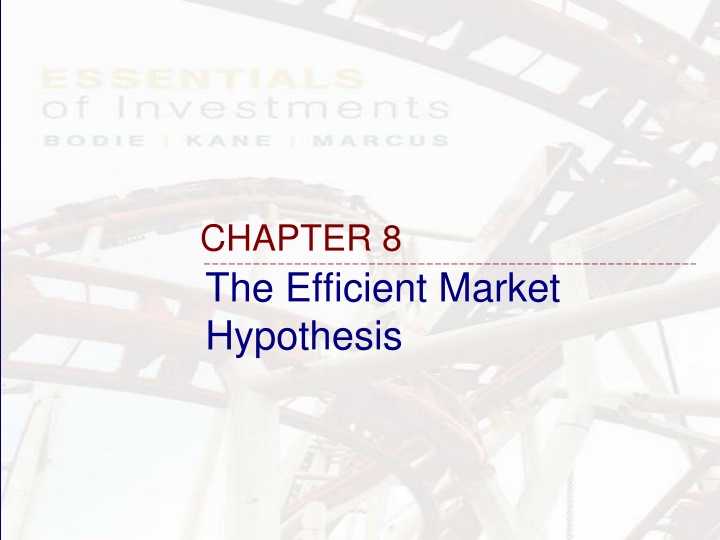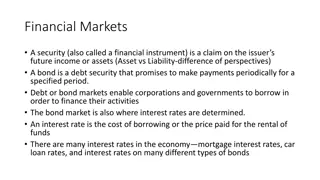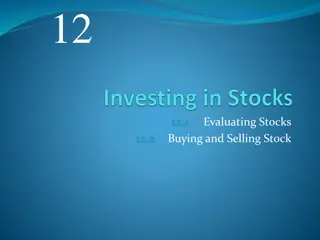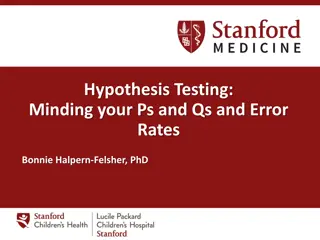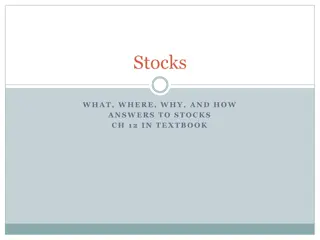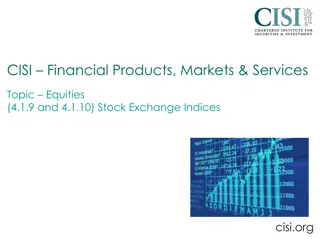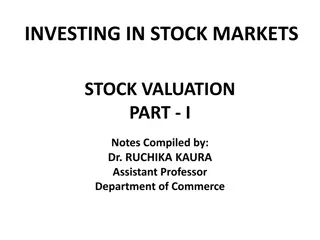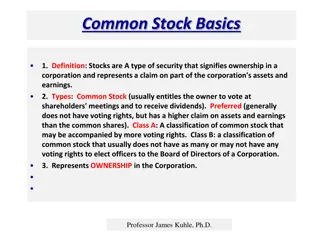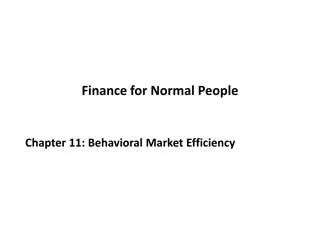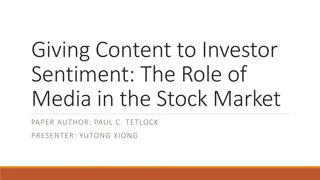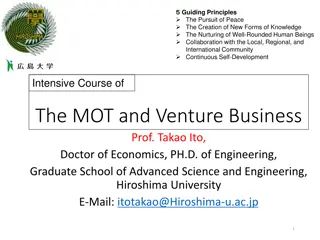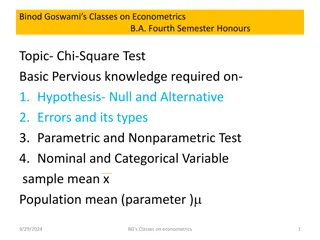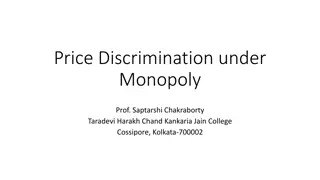Efficient Market Hypothesis: Understanding Stock Price Movements
The Efficient Market Hypothesis (EMH) posits that stock prices are unpredictable in efficient markets, reacting immediately to all news due to competition and information disclosure among analysts. The EMH challenges the notion of predicting stock prices based on past performance, emphasizing the efficient reflection of all available information in current prices.
Download Presentation

Please find below an Image/Link to download the presentation.
The content on the website is provided AS IS for your information and personal use only. It may not be sold, licensed, or shared on other websites without obtaining consent from the author.If you encounter any issues during the download, it is possible that the publisher has removed the file from their server.
You are allowed to download the files provided on this website for personal or commercial use, subject to the condition that they are used lawfully. All files are the property of their respective owners.
The content on the website is provided AS IS for your information and personal use only. It may not be sold, licensed, or shared on other websites without obtaining consent from the author.
E N D
Presentation Transcript
CHAPTER 8 The Efficient Market Hypothesis
Learning Goals of Chapter 8 Introduce the Efficient Market Hypothesis (EMH) ( ) Discuss the practicability of technical and fundamental analyses ( ) and the active asset management ( ) under different forms of the EMH Cite evidence that supports or disproves the EMH Examine the EMH by analyzing the performance of stock analysts and fund managers There is a lot of descriptive content in Ch. 8, so I rearrange the lecture slides in a more logical and succinct way 8-2
8.1 RANDOM WALKS AND THE EFFICIENT MARKET 8-3
Efficient Market Hypothesis (EMH) Kendall (1953) first found that it is almost impossible to identify predictable patterns in stock prices Stock prices seem to evolve randomly The past performance provided no way to predict future price movements Some economists treated these results from the irrationality ( ) of the market Because they believe that similar to predicting the business cycle or GDP of a nation, it is possible to predict stock prices They soon realized that random price movements indicate a well-functioning or efficient market, not an irrational one 8-4
Efficient Market Hypothesis (EMH) The following arguments support that the stock prices are unpredictable in efficient markets Stock prices react immediately to all news due to the pursuit for profit Suppose there is an accurate forecast that the stock price of XYZ will rise by 30% in one week Every investor intends to buy the shares of XYZ, but no stockholders of XYZ are willing to sell As a result, the stock price rises immediately to a proper level to reflect this good news Therefore, a forecast about future performance leads to current stock price movement Equivalently, we can say that the current stock price has already reflected all information that could be used to predict the future performance of the firm 8-5
Efficient Market Hypothesis (EMH) Competition leads to information disclosure Competition among many professional, highly paid, aggressive analysts ensures that all relevant information can be discovered soon in the stock markets Based on the discovered information, they can trade stocks such that stock prices ought to jump to their proper levels by reflecting available information New information occurs and is discovered randomly Stock prices change randomly We can further conclude that the past performance is irrelevant with future performance The pursuit for profit and the competition among investors to discover information are key factors to make market efficient 8-6
Efficient Market Hypothesis (EMH) The notion ( ) that current stock prices fully reflect all available information is referred to as the Efficient Market Hypothesis (EMH, ) In other words, if the stock prices can reflect new information immediately, then the market is efficient 8-7
Cumulative Abnormal Returns (CAR, ) For Takeover Attempts The abnormal return ( ) (or risk-adjusted return) is the difference between the actual return and the predicted return based on the CAPM, i.e., it is the ? In most takeover events, the acquiring firm pays a substantial premium ( ) over the current market prices of the merged firm (due to the synergy effect ( ): the value of the combined firm is higher than the sum of the values of individual firms) The figure shows that the announcement of a takeover attempt should cause the stock price of the merged firm to jump immediately In addition, there is no further drift in prices after the announcement date, including the day on which the takeover transaction is physically completed 8-8
Stock Price Reaction to CNBC Reports The time 0 is the time point at which the stocks are mentioned in the on-air stock reports during the Midday Call segment on CNBC Busse and Green (2002) show that most of the stock price responses to the announcements of dividends or earnings occur within a very short period after the announcements (almost immediately) For firms with positive (negative) reports, the stock prices reflect the news in 5 minutes (12 minutes) 8-9
Different Forms of the EMH Three forms of the EMH: Weak-form, semistrong-form, and strong-form EMH Different forms of the EMH are determined by different information sets that security prices can reflect Weak-form EMH ( ): Security prices already reflect all information contained in the history of past trading If the historical data conveyed reliable signals about future performance, all investors already would have leaned to exploit the signal Implies that the trend or technical analysis ( ) is fruitless (discussed in the next section) 8-10
Different Forms of the EMH Semistrong-form EMH ( ): Stock prices already reflect all publicly available information, including past trading prices and volumes, fundamental data on the firm s product line, balance sheets, earning forecasts, etc Implies that fundamental analyses ( ) to study earnings and growth forecasts do not work (discussed in the next section) 8-11
Different Forms of the EMH Strong-form EMH ( ): Stock prices reflect all relevant information, including public information and private (inside) information available only to company insiders Implies that even for investors with private information, they cannot earn abnormal returns SEC limits the trading by corporate officers, directors, and large stockholders and requires these insiders to report trades to prevents them from profiting by exploiting their privileged situation Degree of efficiency differs in various markets or different securities Emerging markets, markets with less rigorous disclosure requirement, and small stocks with less notice by stock analysts are less efficient 8-12
Information Sets for Different Forms of the EMH The above figure shows the information set of different EMH forms (strong- form > semistrong-form > weak-form) Semistrong-form efficiency implies that weak-form efficiency holds (but NOT vice versa) Strong-form efficiency implies that both semistrong-form and weak-form efficiency hold (but NOT vice versa) 8-13
8.2 IMPLICATIONS OF THE EMH (For Technical and Fundamental Analyses and Active vs. Passive Management ) 8-14
Types of Stock Analysis Technical Analysis ( ) Using past information of prices and trading volumes to search for recurrent and predictable patterns or proxies for buy/sell pressure in security prices (introduced in Ch 9) Buying recent winners or shorting recent losers ( ) are typical examples: Buy (short) stock performing relatively well (poor) recently because such trend may continue for a long enough period of time to offer profit opportunities For markets in any form of efficiency, the technical analysis based on past information is worthless since the market prices already reflect all past information 8-15
Types of Stock Analysis Fundamental Analysis ( ) Using publicly economic and accounting information to predict stock prices (Ch. 12 to Ch. 14) In a semistrong-form or strong-form efficient market, fundamental analyses do not work Because many individual and institutional investors conduct fundamental analyses based on public information to design their investment strategies, the security prices already reflect all public information In contrast, fundamental analyses are feasible in weak-form efficient and inefficient markets However, due to the competition among investors, you can make money only if your analysis is better than that of your competitors, i.e., you can predict the performance of firms more accurately than the prediction of other investors 8-16
Implications of EMH for Active or Passive Management Three reasons to suggest that the active management is not preferred in efficient markets 1. Huge efforts to find securities with minor mispricing by technical or fundamental analyses in efficient markets An example for a fund adopting active management: Consider a fund with a $5 billion portfolio, and the fund manager plan to organize a research to pursue the increase of the rate of return by 0.1% per year That means the fund manager would be willing to spend up to $5 million (= 0.1% $5 billion) on research The active portfolio management is economically feasible only for managers of large portfolios but not appropriate for individual investors magnitude issue ( ) Even for institutional investors, is it worthy to spend those huge efforts? 8-17
Implications of EMH for Active or Passive Management 2. Difficult to judge the degree of mispricing and whether it is sufficiently large to repay the costs for developing and implementing active strategies 3. Difficult to distinguish the change of the performance coming from the researches and/or the fluctuations of the market Because of that, it is skeptical that whether mutual funds have the ability to discover mispriced stocks Proponents of the EMH believe the active management is largely wasted in an efficient market and they advocate a passive management that makes no attempt to outperform the market 8-18
Implications of EMH for Active or Passive Management Passive investment strategy is to buy a well- diversified portfolio without attempting to search out mispriced securities One common strategy for the passive management is to invest in an index fund, which is designed to replicate the performance of the market portfolio underlying the index The fees is relatively lower because an index fund does not need to pay analysts to assess stock prospects and incurs less tax and transaction costs due to its low turnover rate 8-19
Implications of EMH for Active or Passive Management Markets are weak-form efficient or worse Active management Conduct security analyses, like fundamental and/or technical analyses, to pick securities For weak-form efficient or worse markets, it is valuable that stock analysts generate reports and send them to investors based on the results of fundamental analyses For inefficient markets, it is also possible to timing the market based on the technical analyses Markets are semistrong-form efficient or better Passive management Buy and hold well-diversified portfolios, like index funds 8-20
The Role of Portfolio Management in an Efficient Market The most important function of portfolio managers in efficient markets is to construct portfolio to eliminate firm-specific risk by diversification Moreover, the role of the portfolio manager in an efficient market is to tailor the portfolio for the needs of investors, rather than to outperform the market Investors optimal positions vary according to many factors, like age, tax bracket, risk aversion, or employment status For example, for retired persons, they may prefer funds providing high and stable dividend yields such that they can receive regular incomes from the funds 8-21
Empirical Tests of Market Efficiency Persistent profitable strategies or outperforming fund managers market inefficiency Three issues causes debate of market efficiency Roles and performance of professional investors Proponents of the EMH believe that the existence of professional investors can result in efficient markets Magnitude issue: Stock prices are not far from fair values and only managers of larger portfolios can exploit minor mispricing to earn enough trading profits (see Slide 8-17) Difficult to identify professional investors effort and performance (see Slide 8-18) Thus, we can conclude neither the effort of professional investors is valuable nor their existence results in an efficient market, although their actions are indeed the driving force to let market prices move to fair levels 8-23
Empirical Tests of Market Efficiency Selection bias issue ( ) Another method to examine the EMH is to test all trading strategies in the market. If they can not provide abnormally higher returns, we can conclude the market is efficient Assuming that you discover an investment strategy that really makes money, what will you do? Hence, the trading strategies we observe in the market have been preselected in favor of failed attempts, so we cannot evaluate the true ability of portfolio managers to invent profitable strategies You cannot deny the possible existence of profitable strategies that are not released and therefore the possibility that the market is not efficient 8-24
Empirical Tests of Market Efficiency Lucky event issue ( ) Some studies examine the EMH according to the performance of fund managers. If they cannot beat the market, then we can conclude that the market is efficient However, if many professional investors use a variety of schemes to make fair bets, statistically speaking, some will be lucky and win a great majority of bets (e.g., Warren Buffett), and some will be unlucky and lose a lot So, we cannot conclude that the superior record of few winners disprove the efficient market hypothesis although what we heard are all about the feats of winners Proper tests (discussed in Section 8.4) may include: To study the distribution or the average of the performance of fund mangers To test whether the winners can repeat their performance in another periods, i.e., to examine the consistency of the performance of fund managers 8-25
Weak-Form Tests: Patterns in Stock Returns Patterns from the past information can be found Markets are not weak-form efficient Returns over short horizons (< 1 year) For weekly returns of NYSEindividualstocks, fairly small magnitude of positive serial correlation is found For 3- to 12-month periods, there is some evidence of positive serial correlation in both the aggregate market andportfolios of best- and worst- performing stocks (is also known as the momentum effect ( )) Returns over long horizons (3 to 5 years) Pronounced negative serial correlation in the performance of the aggregate market 8-26
Weak-Form Tests: Patterns in Stock Returns The reversal effect ( ) for extremely performing individual stocks Many studies suggest that over long horizons, the performance of extreme-performing stocks tends to reverse, i.e., losers rebound and winners fade back De Bondt and Thaler (1985) find that the worst-performing portfolio (according to 5-year historical returns) outperform the best-performing portfolio in the following three years The reversal effect implies a contrarian ( investment strategy investing in recent losers and avoiding recent winners should be profitable Possible explanation for the short-term momentum and long-term reversal effects Stock market might overreact ( ) to news, and such overreaction leads to momentum effect over short horizons Subsequent correction of the overreaction ( ) leads to negative serial correlation (the reversal effect) over longer horizons ) 8-27
Semistrong Form Tests: Market Anomalies Efficient market anomalies ( ): The phenomenon difficult to reconcile with the semistrong-form EMH that several easily accessible quantity (e.g., dividend yield, P/E ratio, or firm size) seem to predict returns of stock markets or individual assets Predictors of aggregate market performance Fama and French (1998): Returns on stock market are high when dividend yields are low Campbell and Shiller (1988): Earnings yield (earnings per share price) can predict stock market returns Keim and Stambaugh (1986): Spreads between yields in bond markets can predict stock market returns (see confidence index on Slide 9-38) 8-28
Semistrong Form Tests: Market Anomalies P/E ratio (price/earning ratio, ) effect P/E ratio is the inverse of earnings yield Basu (1977, 1983) found that the portfolios with low P/E have higher returns than those with high P/E The P/E ratio effect holds even for returns adjusted for portfolio beta, i.e., the return in excess of the return predicted by CAPM A possible explanation is that the CAPM beta cannot fully adjusts for risk, and P/E can act as a useful indicator of another source of risk 8-29
Semi-Strong Form Tests: Market Anomalies Small-Firm Effect ( ) Banz (1981) examined the small-firm effect The smaller-firm portfolios tend to be riskier (with higher betas), so it is not surprised that they should provide higher expected rates of return Even when returns are adjusted for risk using the CAPM, there is still a consistent premium of the smaller-sized portfolios See the figure on the next slide Invest in low-capitalization stocks is a simple rule to earn more abnormal returns, i.e., earn higher returns for bearing the same level of the systematic risk, since any investor can measure firm size at little cost 8-30
Returns in Excess of Risk-Free Rate and in Excess of the SML This figure shows the historical performance of portfolios formed by classifying the NYSE stocks into 10 portfolios according to the firm size each year Returns in excess of CAPM, also known as abnormal returns ( ), means to calculate the results of ri [rf + i(rM rf)] 8-31
Semi-Strong Form Tests: Market Anomalies Neglected-firm and liquidity effects ( ) Neglected-firm effect Small firms tend to be neglected by large institutional traders, so information about smaller firms is less available (see Arbel and Strebel (1983) and Arbel (1985)) This information deficiency makes smaller firms riskier investments that command higher returns (another way to explain the small-firm effect) Since small and less-analyzed stocks are in general less liquid and less-liquid stocks usually provide higher returns, Amihud and Mendelson (1986, 1991) intend to use the liquidity risk on stock returns to explain both the small- and neglected-firm effects Difficult to exploiting illiquidity effect: The high trading costs that virtually define illiquidity can easily wipe out any apparent abnormal profit opportunity 8-32
Semi-Strong Form Tests: Market Anomalies Book-to-market ratio ( ) Fama and French (1992) showed that B/M ratio can be a powerful predictor of stock returns, i.e., high B/M ratio stocks offer higher expected return (see the figure on the next slide) In addition, they also found that the dramatic dependence of returns on book-to-market ratio is independent of beta (betas for these ten groups are almost indistinguishable), so the same pattern can be derived by comparing the risk-adjusted returns for the ten groups 8-33
Average Annual Return as a Function of Book-to-Market, 1926-2022 The decile with the highest B/M ratio has an average annual return of 16.5%, while the lowest B/M ratio decile has an average of only 11.3% 8-34
Semi-Strong Form Tests: Market Anomalies Post-Earnings Announcement Price Drift Although the EMH suggests the stock price should jump immediately when good or bad news is made public, stock prices response to firm s earnings surprises in a sluggish ( ) way (see the figure on the next slide) Therefore, it is possible to earn abnormal profits by simply purchasing a stock portfolio of positive- earnings-surprise companies Since predictable continuing trends ought to be impossible in an efficient market, so this phenomenon is still a anomaly 8-35
Cumulative Abnormal Returns (CAR) in Response to Earnings Announcements Rendleman, Jones, and Latane (1982) classified stocks into 10 deciles based on the magnitude of the surprise of the earnings, and calculated CARs for each decile for the following 3 months Earnings surprise is the difference between the actual announced earnings and the expected earnings from market participants There are indeed jumps on the announcement day to reflect the earnings surprise, but the stock price continues to move in the same direction of the jump for the following 3 months 8-36
Strong-Form Tests: Inside Information It is not surprising if insiders are able to make superior profits in their trading firm s stock (see Jaffe (1974), Seyhun (1986), Givoly and Palmon (1985), etc.) In other words, it is not expected that markets are strong-form efficient In order to prevent the inside trading hurts the interests of investing public, SEC requires all insiders to register their trading activities and release this information to the investing public 8-37
Interpreting the Evidence The P/E, small-firm, B/M, short-term momentum, and long-term reversal effects are currently the most puzzling phenomena in empirical finance Two streams of explanations: Risk Premiums ( ) vs. Market Inefficiencies ( ) Fama and French (1993) argue that these effects can be explained as manifestations of risk premiums ( ) (in their three-factor model, size and B/M ratios act as proxies for other fundamental risks) Indeed, not only rM can reflect the business cycle, rSMB and rHML seem to predict the business cycles in many countries as well (see the next slide) 8-38
Return to Style Portfolio as a Predictor of GDP Growth This figure shows the difference between the average rSMB (rHML) before a good GDP growth and the average rSMB (rHML) before a poor GDP growth Positive value means the style portfolio does better in years prior to good macroeconomic performance The differences are significantly different from zero for many countries, which indicates there must be some relationship between the rSMB (rHML) and the business cycle and thus rSMB (rHML) can act as proxies for other fundamental risks 8-39
Interpreting the Evidence Lakonishok, Shleifer, and Vishny (1994) argue that these effects are evidences of inefficient markets Investors extrapolate ( ) past performance too far into the future Therefore overprice (underprice) firms with recent good (poor) performance Ultimately, when investors recognize their errors, prices move reversely This argument can explain the short-term momentum, the long-term reversal, and partial P/E ( ), small-firm ( ), B/M effects (+) Prices decrease (increase) P/Es decrease (increase), tend to be small (large) firms, and B/Ms increase (decrease) Investors seem too pessimistic (optimistic) about the future according to recent poor (well) performance. When these too- extreme expectations are corrected, firms with recent poor performance will outperform firms with recent well performance 8-40
Interpreting the Evidence Anomalies ( ) or Data Mining ( ) Some academics wonder whether these anomalies are really unexplained puzzles in financial markets, or whether they instead are an artifact of data mining Some anomalies have not shown staying power after being reported Data mining: Rerun the computer to analyze past returns over and over and examine stock returns along enough dimensions simple chance may cause some criteria to appear to predict returns Factor zoo: too many risk-premium factors proposed Until 1991, only one new factor per year appeared In the last two decades, the number of new factor accelerated dramatically, exceeding 300 in a year by 2016 8-41
Interpreting the Evidence In-sample vs. out-of-sample tests ( vs. )) to address the problem of data mining Out-of-sample tests: Find a data set that has not already been researched and see whether the relationship in question shows up in the new data set Testing anomalies in the period from the end of each study s sample period to the publication date: Portfolio returns are on average 28% lower 8-42
8.4 MUTUAL FUND AND ANALYST PERFORMANCE (Another Indicators for the Degree of Efficiency of Markets) 8-43
Stock Market Analysts Markets are efficient Almost all securities reflect news quickly and are at their fair prices Stock analysts reports are worthless, and fund managers cannot earn abnormal returns and show persistent performance Do stock analysts add value mixed evidence Womack (1996) Positive (negative) changes of stock analysts recommendationsare associated with the changes of stock prices by 5% ( 11%) Are price changes due to stock analysts superior information or pressure brought by the recommendations themselves? Womack argues that the price impact seems to be permanent, which supports that stock analysts do reveal new information 8-44
Stock Market Analysts Jegadeesh, Kim, Krische, and Lee (2004) Changes in consensus recommendations are associated with price changes, but the level of consensus recommendations is an inconsistent predictor of future stock performance (Consensus recommendations is proxied by the average of all outstanding recommendations for a given firm) Barber, Lehavy, McNichols, and Trueman (2001) Firms with the most-favorable recommendations outperform those with the least-favorable recommendations (level of consensus recommendations does matter) 8-45
Mutual Fund Managers Persistently well or poor performance for fund managers mixed evidence The phenomenon may be caused from potential measurement error for benchmark returns Maybe some funds bear more (less) systematic risk such that can provide consistently higher (lower) rate of return Therefore, we should examine the abnormal (or risk- adjusted) return (i.e., the difference between the actual returns and the returns predicted by the CAPM or said the in the CAPM) Malkiel (1995) computed these abnormal returns ( )for a large sample of mutual funds between 1972 and 1991 (see the figure on the next slide) 8-46
Estimates of Individual Mutual Fund Alphas Based on CAPM The distribution of is near a normal distribution, with a mean that is slightly negative but statistically indistinguishable from zero Therefore, it suggests that these funds, on average, does not outperform the market index on a risk-adjusted basis 8-47
Mutual Fund Managers Another measurement error: Since mutual funds tend to hold in equity of smaller firms, whereas the S&P 500 is comprised of large firms, mutual funds tend to outperform the S&P 500 market portfolio due to the small-firm effect The abnormal (or risk-adjusted) return of the Fama- French three-factor model should be examined Some mutual funds exploit the momentum or reversal effects to earn abnormal returns The abnormal (or risk-adjusted) return of the Carhart four-factor model (introduced next) should be examined 8-48
Mutual Fund Managers Carhart (1997) proposed a four-factor model to study the performance of mutual funds Four factors include the rS&P 500, rSMB, rHML, and prior- year stock market return (PR1YR) R R r = + + + SMB SMB i r + PR1YRPR1YR i + e HML HML i i i iM M i PR1YR, like rSMB and rHML, is the return of a zero- investment, factor-mimicking portfolio to capture the intermediate-term momentum effect PR1YR is defined as the difference of the this-year average returns between the best 30% performing stocks and the worst 30% performing stocks on NYSE, Amex, and Nasdaq in the prior year A positive (negative) coefficient for PR1YR indicates that the mutual funds tend to invest and hold the current winner (losers) in the next period 8-49
Estimates of Individual Mutual Fund Alphas Based on the Four-Factor Model Since s are distributed normally around 0, the evidence is consistent with market efficiency based on the 4-factor model By examining the of the 4-factor model, Carhart finds that there are no consistently superior performers, i.e., the consistent better (unadjusted) performance observed in the market is not due to the better skill of fund managers, but due to the consistent investment in smaller firms, higher B/M firms, or the past winners On the contrary, there could be consistently inferior performers, but Carhart attributes the repeated weak performance to the structure of the expenses and transaction costs of mutual funds rather than to pick wrong stocks consistently 8-50
